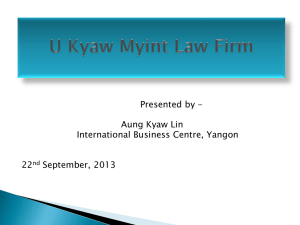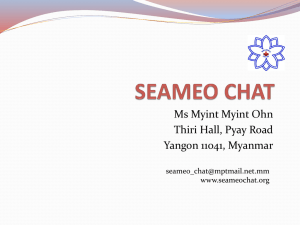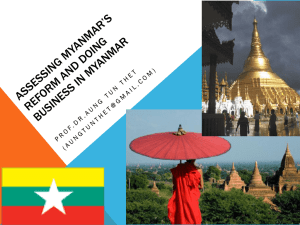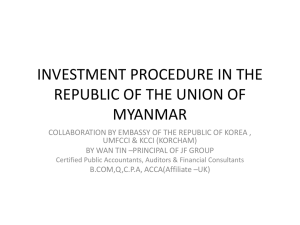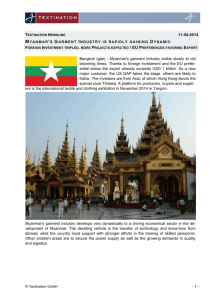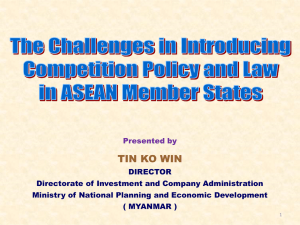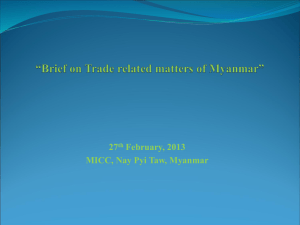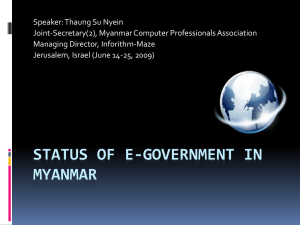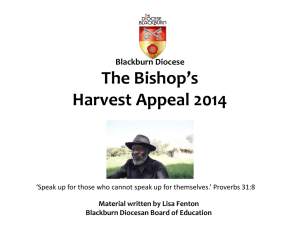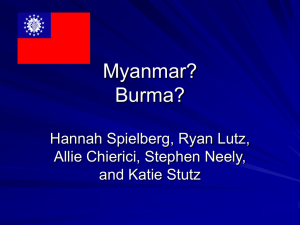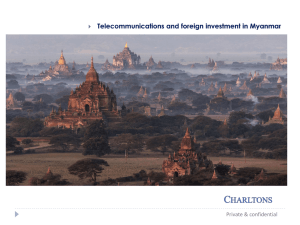Khine Khine Nwe_WHEF 2013 Bangkok for DKKN
advertisement
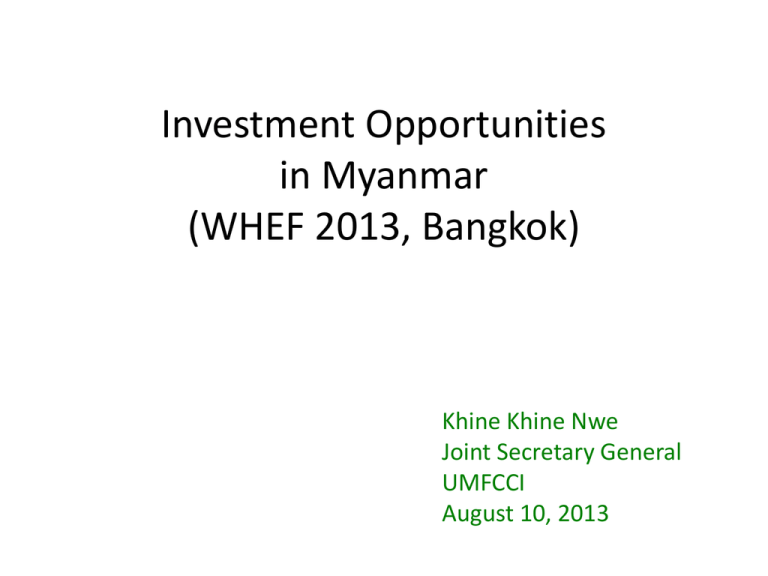
Investment Opportunities in Myanmar (WHEF 2013, Bangkok) Khine Khine Nwe Joint Secretary General UMFCCI August 10, 2013 GDP - composition by sector: agriculture: 43% industry: 20.5% services: 36.6% (2011 est.) Labor force: 37.35 million (2011 est.) country comparison to the world: 19 Employment - by occupation: agriculture: 65% industry: 12% services: 23% (2011 est.) Total land boundaries5,867 km - China 2,185 km - Lao 235 km - Thailand 1,800 km - Bangladesh 193 km - India 1,463 km ECONOMIC CORRIDORS Myanmar is well situated on the Northern Corridor, North-South Economic Corridor and East-West Economic Corridor and, Southern and Western Corridors. Although East-West Economic Corridor known as EWEC connects eastern ASEAN countries, Western Corridor and Southern Economic Corridor are the key base to establish Mekong-India Economic Corridor (MIEC) by extending the link to Dawei of Myanmar. What’s new in Myanmar, what’s news about Myanmar • New Government The first democratically elected government • New Political Landscape Measures to achieve positive changes in political, economic and social spheres are put in place, in line with the market conditions and international circumstances. June 2013 : World Economic Forum 2013 : SEA Games 2014 : Asean Chairmanship • New Economic Landscape Myanmar is in the process of instituting a series of policy and strategic reforms with the aims of achieving national development and catching up with the economic success of neighboring countries. • New Development Ideology • to reduce poverty and to increase wealth • to lift the country out of the least developed country status • to ensure job opportunities and health and social security benefits for its people New National Economic Policy • Sustainable development of agriculture sector towards industrialization • Equitable and proportionate development among Regions and States • Inclusive development of entire people • Develop the Quality statistical system of statistics and Goals of the Fifth Five-Year Plan (2011-12 to 2015-16) •To achieve an average annual GDP growth rate of 7.7% •To increase industrial share of GDP from 26% to 32% together with an increase in the service sector, reducing the currently high share of agriculture. •To increase Per capita GDP growth between 30-40% from the base year of 2010, which will help attain the first goal of MDG in reducing the poverty incidence by half over the period 2000-2015. Source: MNPED New Reforms and Laws • • • • Finance and Banking Unification of exchange rates in April 2012 Adopted a managed floating rates Foreign currency reserve US$7 billion in September 2011 and expected to US$ 9 billion by end of the year 2013. • Central Bank Law (approved July 13, 2013 by Parliament) • Myanmar’s Foreign Investment Law • “FIL” is revised with more exemptions and relief and approved • • • • • by the Parliament in November 2012. Ministry of National Planning and Economic Development issued the Foreign Investment Law Regulations, passed on 31 January 2013. Myanmar Investment Commission announced List of Prohibited Economic Activities List of Economic Activities allowed in the form of Joint Venture with Myanmar citizens and List of Economic Activities which shall be allowed under the specific circumstances Aims of the New FIL • to produce products using abundant resources of the country, for the people to enjoy sufficiently and to enable the surplus to export • to open up more employment opportunities for the people, as business develop and expand • to develop human resources • to develop infrastructures, both hard and soft • to develop respective area of studies in communication networks, transport business such as rail, ship, aircraft, throughout the entire country, to meet the international standard • To promote nationwide development and to encourage citizens to work in relevance with other countries • To promote the building up of the economic enterprises and investment business in accord with the international norms. • Special Economic Zone Law : Existing law enacted in February 2011, being revised to be one of the most investor friendly laws in the region. • Taxation Law : Revised with effect from 1st April, 2012, reduction of tax rates to induce foreign and local investment. • Intellectual Property Law : 11th draft in process, based on minimum standard and maximum flexibility, expected end 2013 or early 2014. • New York Convention : Submitted instrument of accession to the Convention on the Recognition and Enforcement of Foreign Arbitral Award (1957) in Aoril 2013. Changes in Trade and Investment Environment • Commercial tax and Income tax for export - 10% to 0 % (except for 18 special commodities) • Income tax- 10% to 0% (CMP including garment exports) • Reduce Cargo inspection stations at Border Checkpoints • Liberalization in documentation process for trade procedure • Liberalized in car import- any citizen with foreign exchange account is allowed to import car • Online Licensing system will be introduced soon. • Myanmar Investment Commission reorganized. • One Stop Service for Investors in Yangon (DICA) started on April 10 Top 10 Exports & Imports (2011-2012) No Items Value ( US Dollar in Million) No Items 1 Natural Gas 3463.482 1 Petroleum Products 2079.765 2 Bean and Pulses 1120.938 2 Vehicles & Spare Parts 1178.761 3 jade 780.340 3 603.768 4 Marine Products 705.866 Iron & Steel Construction materials 5 Garment 498.608 4 Iron and Steel Materials 512.460 Rice 5 Machinery and Spare Parts 511.518 6 324.622 6 Palm Oil 388.291 7 Rubber 311.090 7 Plastic Raw Materials 314.129 8 Teak log 283.923 8 Ships, Boats and Spare Parts 311.383 9 Hardwood Log 272.883 9 Pharmaceuticals 226.061 10 Corn 216.789 10 Fertilizers 174.590 Total 9097.000 Total Value (US Dollar in Million) 9053.780 Top 3 Trade Partners of Myanmar (2012-2013) Export Import Total (mil USD) China 2166.40 2748.20 4914.60 Thailand 3752.16 789.50 4541.66 Singapore 282.89 2500.02 2782.91 Source: MOC FOREIGN INVESTMENT OF PERMITTED ENTERPRISES AS OF (30/6/2013) (BY SECTOR) (US $ in million) Sr. Permitted Enterprises No Approved Particulars No. Amount % 1 Power 6 19237.92 44.82 2 3 Oil and Gas Mining 115 67 14372.27 2829.694 33.48 6.59 4 Manufacturing 255 2730.883 6.36 5 Hotel and Tourism 47 1585.811 3.69 6 Real Estate 19 1056.453 2.46 7 Livestock & Fisheries 26 347.124 0.81 8 Transport & Communication 16 313.906 0.73 9 Industrial Estate 3 193.113 0.45 10 185.351 0.43 2 37.767 0.09 11 577 38.752 42929 0.09 100 10 Agriculture 11 Construction 12 Other Services Total Source: DICA 2013 FOREIGN INVESTMENT OF PERMITTED ENTERPRISES AS OF (30/6/2013) (BY COUNTRY) ( US $ in million ) Sr. Permitted Enterprises Particulars No Approved No. Amount 1 China 47 14185.529 2 Thailand 66 9979.443 3 Hong Kong 49 6393.334 4 Republic of Korea* 78 3013.705 5 U.K* 60 3045.434 6 Singapore 90 2358.946 7 Malaysia 44 1034.785 8 France 2 469 9 Viet Nam*** 6 511.186 10 India 9 283.1 11 Japan 35 270.283 12 The Netherlands 7 249.136 13 U.S.A 15 243.565 14 Indonesia 12 241.497 15 Philippine 2 146.667 16 Russia Federation 2 94 17 Australia 14 99.246 18 Austria 2 72.5 19 Panama 2 55.101 20 United Arab Emirates 1 41 21 Canada 16 41.883 22 Mauritius 2 30.575 23 Germany 2 17.5 24 Republic of Liberia** 2 14.6 25 Denmark 1 13.37 26 Cyprus 1 5.25 27 Macau 2 4.4 28 Switzerland 1 3.382 29 Bangladesh 2 2.957 30 Israel 1 2.4 31 Brunei Darussalam 3 4.273 32 Sri lanka 1 1 Total 577 42929.047 Source: DICA 2013 % 33.04 23.25 14.89 7.02 7.09 5.49 2.41 1.09 1.19 0.66 0.63 0.58 0.57 0.56 0.34 0.22 0.23 0.17 0.13 0.1 0.1 0.07 0.04 0.03 0.03 0.01 0.01 0.01 0.01 0.01 0.01 0 100 Increase of FDI Since September 2012 Existing Enterprises (30/9/2012) Sr. No. Particulars 1 Oil and Gas Approved No. Amount 62 13474.728 Existing Enterprises (30/6/2013) Approved % No. Amount 43.37 64 13665.028 % 42.33 5 13207.921 9 2304.496 40.92 31 1254.475 3.89 2.04 155 992.505 3.07 275 0.89 7 275.000 0.85 2 179.113 0.58 2 179.113 0.55 Agriculture 6 154.07 0.50 6 154.070 0.48 Transport & Communication 7 137.676 0.44 7 137.676 0.43 7 64.946 0.21 8 87.712 0.27 5 232 8.067 31068.182 0.03 8 21.827 0.07 302 32279.823 100.00 2 Power 4 13037.498 41.96 3 Mining 8 2289.162 7.37 4 Hotel and Tourism 30 814.475 2.62 5 Manufacturing 94 633.447 6 Real Estate 7 7 Industrial Estate 8 9 10 Livestock & Fisheries 11 Other Services Total 100.00 7.14 SEZs Kyaukphyu SEZ Dawei SEZ Thilawa SEZ Source: Ministry of Industry Agriculture agro-based country Potential food basket for Asia Vast potential of land resources as well as different networks of irrigation facilities for the expansion of Agriculture Sector both horizontally and vertically MINERAL SECTOR Western Ranges Eastern Highlands Abundance of precious gem stone such as ruby, sapphire, jade and diamond. Ruby Nickel Chromite PGM Central Belt Lead,Zinc Copper Silver Tungsten Antimony Iron accounts for 90% of world supply and the largest jade resource country in the world. Jade is second largest export item with the amount of USD 2.2 Billion. 2.8 Billion USD investment by 64 Porphyry Copper Gold Coal Oil & Gas Enterprises. 22 INDUSTRY SECTOR • • • • • Foodstuff, Textile, Personal Goods, Household Goods, Leather Products • Transport Equipment, • Building Materials, • Pulp and Paper, • • • • Chemicals, Pharmaceuticals, Iron and Steel, Machinery and Plant Developing together with other sector such as agriculture, fishery, mining and oil and gas sectors ; plenty of opportunities to invest in manufacturing sector such as labour intensive industries, Small and Medium Enterprises (SMEs) and production Network FDI projects. 23 Garment Industries 900 Myanmar Garment Export Trend (2001-11) 800 High Growth Potential for 700 Export to Japan, Korea, EU US $ in Million 600 and USA 500 Large Domestic Demand for 400 300 textile and clothing (about 200 USD 56 million, 75% of 100 which has been imported.) 0 2001 4/13/2015 2003 2005 2007 2008 2009 2010 2011 Power At least 37,000 megawatts can be generated from hydro all over the country in the Ayeyarwaddy, Sittaung, Thanlwin and Chindwin river basins and only about 745 megawatts has been developed so far. Energy Sector potentials for cooperation in the downstream projects in Energy Sector such as refinery plant and fertilizer plants. OIL & GAS SECTOR Myanmar possesses significant natural gas and oil reserves. 10th largest resource of natural gas in the world, over 90 trillion cubic feet. 26 FORESTRY Expansive forest which covers half of total area of the country, exports 80% of world teak supply Major exporter of teak in the world many hardwood and softwood species that have been neglected in the past processing value-added products commercially for exports as well Potentials for Value added production of Minor Forest Products: Bamboo, Cane, Rattan 27 FISHERIES SECTOR A long sea coastline of 2,832 kilometers associated with 229,000 square kilometers of continental shelf and 486,000 square kilometers of exclusive economic zone Fishery resources that are currently being used is less than 60% of sustainable yield, potential of 1.05 million MT of fish and 28 fishery product TOURISM SECTOR Booming sector after reform 16.95% increased in 200910, 4.88% increased in 2010-11 and 30% increased in 2011-12 Very new white sand beaches at Myeik Archipelago comprising 800 islands Year round festivals with simple and kind hearted people 29 PROMISING FUTURE BUSINESS 1. Labor intensive manufacturing – garment, footwear, toy, wigs etc… 2. Export oriented agro-based value added industries Huge potential for agricultural production • huge global demand • abundant potential in food supply 3. Supportive Industries • SMEs & SMIs Potential Jobs Opportunities Agriculture Resource Fishery Mining Mineral Processing Forestry Wood Processing Oil & Gas Petrochemical Garment Labor Electronic Parts Assembly Footwear Industry Others Hotel & Tourism Services Food Processing Logistics Real Estate Other Market Potential TOTAL : 2.839 BILLION Neighboring Markets 2 Giants Economies ASEAN Pop 600 mil International Markets EU, USA, Japan, Korea INDIA 1.21 Billion CHINA 1.35 Billion BANGLADESH 145 Million LAO 7 Million 60 Million Domestic market THAILAND 66 Million 60 million Population BAY OF BENGAL ANDAMAN SEA 40.6% OF WORLD POPULATION 32 STRENGTH Abundant trainable labor force with basic education, hardworking, quick learning, sincere and obedient mindset of the people. Well connected to major Asian market, ASEAN, China and India. Strategic location : Geopolitical importance for regional connectivity as the tri-junction of East Asia, Southeast Asia and South Asia. Benefit of late comer in development: can leapfrog. Strong political and economic will of the leaders and strong will of the people to advance forward under the good leadership. 33 Weakness • Poor infrastructure adds up in high production and transaction cost. • Underdeveloped banking and financial system. (Reforms in banking system.) • Shortage of skill workers and middle level technicians. (Skill Development Law, schemes) • Job-hopping from one workplace to another. (Insecurity, Minimum Wage Law, Social Security Scheme) • Lack of financial access, incentives, modern efficient machineries, technology and management. (Training Center) • Transshipment in Singapore. (Corridors and Deep Sea Ports) 34 • • • • THREAT Regional inequality may cause social inequality Competitiveness International pressures amid reforms and economic sanctions. (?) Genuine change! Reversible-irreviserble! Capacity! OPPORTUNITIES Regional hub for multimodal transportation and a potential supply route bypassing the Malacca Strait. Huge Domestic Demand for textile and clothing (about USD 56 million, 75% of which has been imported.) GMS Cross Border Transport Agreement (CBTA) based Transit Transport. Cutting off substantially transaction cost, both time and money. Sole land-bridge between two giant economies, China and India Bharat. High potential to be a “food basket” and “energy source” for Asia (Connectivity Hub). Huge industrial potential for FDI from ASEAN and global supply chains. Lifting of economic sanctions and re-instatement of GSP/EBA by EU, by US? 36 Conclusion On the right track politically, economically and socially. On the runway to take off which ensures the benefit for investors. Amid abundant opportunities. From blossoms to blooms. 38
